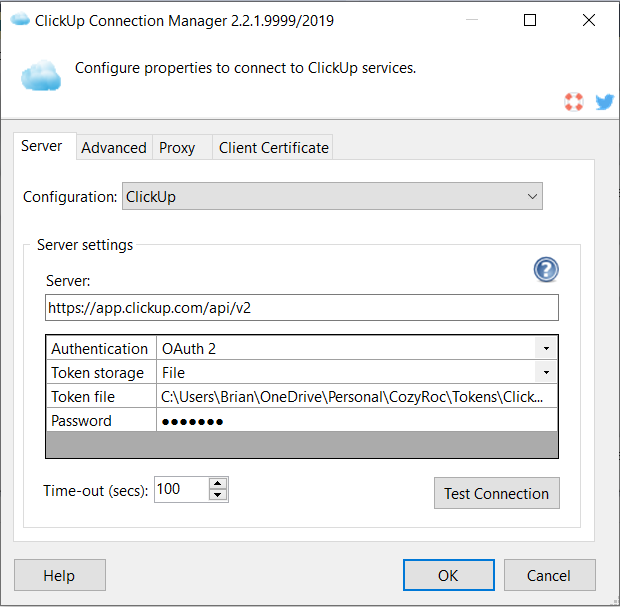A) Configuring a REST Connection Manager
In this article, we will show you step-by-step how to create a REST connection in CozyRoc SSIS+ using the ClickUp API as an example.
You must have Microsoft Visual Studio and CozyRoc SSIS+ installed. This article uses Visual Studio 2017 and SSIS+ 2.2.
Step 1. Open Microsoft Visual Studio and open or create a new Integration Services Project. Right click on the Connection Managers panel and select "New Connection...". In the "Add SSIS Connection Manager", scroll down and select REST, then click "Add...". This will open the REST Connection Manager, which runs on RCM files for each web service's API.

Step 2. From the drop-down menu for "configuration", select ClickUp. Enter the specific base URL for your cloud server instance. A placeholder value contains the generic syntax for the URL.
Step 3a. You have options about how to authenticate your connection. The simplest way is to connect to ClickUp via a standard API key or token by selecting "Token" as the authentication method. The web service application typically has documentation about how to obtain this token key string through the user interface.

Step 3b. In order to use OAuth 2 as an authentication method, you must generate a token using your credentials for the web service you'd like to connect to, in this case ClickUp. You will be prompted for your credentials in the embedded browser after clicking "New" in the "Token file" input box. You may also click the ellipsis to connect with an existing token saved to your machine.

Step 3c. After you log in, you will receive an access token. A refresh token is not always necessary, so you can leave that box blank. Select the file path where you would like to store your token file (a small XML document) and optionally encrypt it with a password.

Step 3d. Sometimes you will need to enter the full URL that is generated after you entered your standard email and password credentials. This URL contains the code for activating your OAuth credentials and is given if you choose to use an external browser for the OAuth authentication process.

Step 4. If you are using OAuth authentication, enter the password for your OAuth token file. For any authentication method, click "Test Connection". You should see an alert box with "Test connection succeeded" if you properly entered your credentials and the service is working.

Next article: Reading Data from an API (GET Requests)
Book a Presales Call
Related Articles
Why the buttons on the REST Connection manager are missing?
Problem: I am not able to configure my REST Connection Manager component. After I select "Configuration", the buttons on the REST Connection manager screen are gone, they are missing . Look at the screenshot below: Solution: A possible reason for ...How to upload an Excel file to Google Drive as a Google Spreadsheet
In order to upload an Excel file to Google Drive as Google Spreadsheet you need to: Create a project in Visual Studio. To establish a Connection Manager to Google Drive, you need to use a Google Drive Connection (see Quick Start >> Establish ...Getting Started with REST API Connections in CozyRoc SSIS+: Section Table of Contents
Guide table of contents: Guide to REST API Connections in CozyRoc SSIS+ Get acquainted with REST API connectors in CozyRoc SSIS+ so that you can integrate data sets and databases across web services and platforms. CozyRoc SSIS+ Components Suite is a ...How to use an XML configuration in a REST Connection Manager
Follow these steps to use the configuration Right Click Connection Managers. Choose New Connection. Select Connection manager for REST connections. In the Configuration drop down choose {Custom}. A wrench appears to the right of the Configuration ...Guide to REST API Connections in CozyRoc SSIS+: Table of Contents
Table of Contents I. Introduction II. Installing CozyRoc SSIS+ A) Installing Visual Studio and SSDT B) How to Download and Install the CozyRoc SSIS+ Components Suite C) Check Software Versions D) Licensing CozyRoc SSIS+ III. The Basics of SSIS+ IV. ...